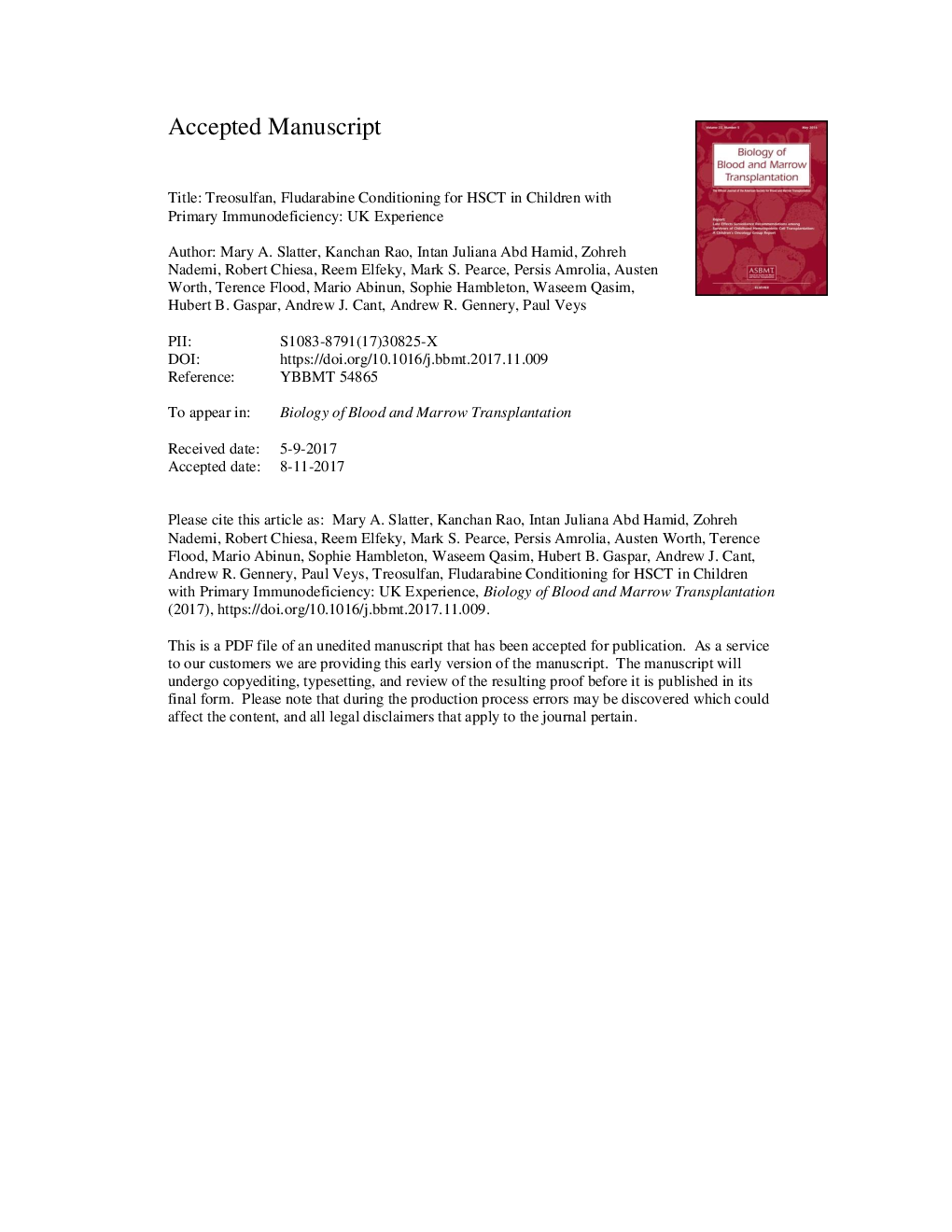| کد مقاله | کد نشریه | سال انتشار | مقاله انگلیسی | نسخه تمام متن |
|---|---|---|---|---|
| 8430091 | 1546230 | 2018 | 39 صفحه PDF | دانلود رایگان |
عنوان انگلیسی مقاله ISI
Treosulfan and Fludarabine Conditioning for Hematopoietic Stem Cell Transplantation in Children with Primary Immunodeficiency: UK Experience
ترجمه فارسی عنوان
تهدید ترئوسولفان و فلوودارابین برای پیوند سلول های بنیادی هماتوپوئیدی در کودکان مبتلا به کمبود ایمنی اولیه: تجربه انگلستان
دانلود مقاله + سفارش ترجمه
دانلود مقاله ISI انگلیسی
رایگان برای ایرانیان
کلمات کلیدی
کمبود ایمنی اولیه، پیوند سلول بنیادی هماتوپوئیت، ترئوسولفان، فلوودارابین، شبیه سازی
موضوعات مرتبط
علوم زیستی و بیوفناوری
بیوشیمی، ژنتیک و زیست شناسی مولکولی
تحقیقات سرطان
چکیده انگلیسی
We previously published results for 70 children who received conditioning with treosulfan and cyclophosphamide (n = 30) or fludarabine (n = 40) before undergoing hematopoietic stem cell transplantation (HSCT) for primary immunodeficiency (PID). Toxicity was lower and T cell chimerism was better in the patients receiving fludarabine, but cohort numbers were relatively small and follow-up was short. Here we report outcomes of 160 children who received homogeneous conditioning with treosulfan, fludarabine, and, in most cases, alemtuzumab (nâ=â124). The median age at transplantation was 1.36 years (range, .09 to 18.25 years). Donors included 73 matched unrelated, 54 1 to 3 antigen-mismatched unrelated, 12 matched sibling, 17 other matched family, and 4 haploidentical donors. Stem cell source was peripheral blood stem cells (PBSCs) in 70, bone marrow in 49, and cord blood in 41. Median duration of follow-up was 4.3 years (range, .8 to 9.4 years). Overall survival was 83%. No patients had veno-occlusive disease. Seventy-four patients (46%) had acute GVHD, but only 14 (9%) greater than grade II. Four patients underwent successful retransplantation for graft loss or poor immune reconstitution. Another patient experienced graft rejection and died. There was no association between T cell chimerismâ>95% and stem cell source, but a significant association was seen between myeloid chimerismâ>95% and use of PBSCs without an increased risk of significant GVHD compared with other sources. All 11 patients with severe combined immunodeficiency diagnosed at birth were alive at up to 8.7 years of follow-up. Long-term studies are needed to determine late gonadotoxic effects, and pharmacokinetic studies are needed to identify whether specific targeting is advantageous. The combination of treosulfan, fludarabine, and alemtuzumab is associated with excellent results in HSCT for PID.
ناشر
Database: Elsevier - ScienceDirect (ساینس دایرکت)
Journal: Biology of Blood and Marrow Transplantation - Volume 24, Issue 3, March 2018, Pages 529-536
Journal: Biology of Blood and Marrow Transplantation - Volume 24, Issue 3, March 2018, Pages 529-536
نویسندگان
Mary A. Slatter, Kanchan Rao, Intan Juliana Abd Hamid, Zohreh Nademi, Robert Chiesa, Reem Elfeky, Mark S. Pearce, Persis Amrolia, Austen Worth, Terence Flood, Mario Abinun, Sophie Hambleton, Waseem Qasim, Hubert B. Gaspar, Andrew J. Cant,
